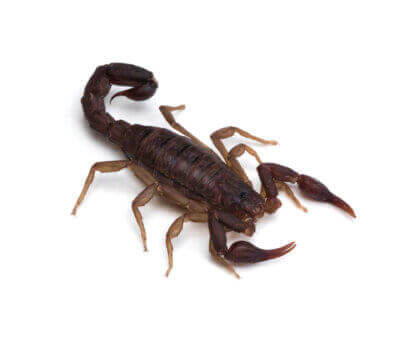Scorpion Facts & Information
Everything you need to know about scorpions
what do scorpions look like

Scorpions are very distinctive arthropods. Their large pinchers are used for climbing, holding prey, defense, or courtship and mating. The stinger, located at the end of the long narrow tail, is used for defense or to kill prey. Scorpions are arachnids and have eight legs like their cousins – spiders, mites, and ticks. They look a bit like small lobsters, equipped with a pair of pincers and a thin, segmented tail that curves over their back. Baby scorpions are called scorplings and are a light creamy color and look just like a scorpion but much smaller. Scorplings can sting and pose the same threats as a mature scorpion. Baby scorpions are a little harder to spot than large scorpions because they’re so small, such a light color, and they don’t glow under black light. Scorpions feed on a wide range of small animals including crickets, spiders, caterpillars, and centipedes. They have very poor vision so they often lie in wait for prey, grabbing anything that wanders into their area. Development from birth to the adult stage may take more than a year. Mature individuals, up to 2-5/8 inches long, may live for another 2 years.
How Do Scorpions Get in the House
Southern devil scorpions are usually found around rocky hillsides. Crumbling rock faces, brick walls, crawl spaces, leaf-covered areas, and log piles are favorite habitats. Scorpions are most likely to be seen in or around houses from April through June but can be active until fall. Dense ground cover, such as leaf litter or mulches, tall grass, wood piles, or general clutter provide excellent protection for scorpions and the small creatures that they eat – that’s really what attracts scorpions in the house. If you have these areas that are attractive to scorpions, then that could be why you have scorpions around your home or business.
Where Do Scorpions Live?

Scorpions bring to mind images of deadly, aggressive creatures that live in the desert regions of the world. However, members of this interesting group can be found in a wide range of habitats. The southern devil scorpion, Vejovis carolinianus, occurs in several southeastern states, including Kentucky. Where do scorpions nest in homes? They prefer crumbling rock faces, brick walls, crawl spaces, leaf-covered areas, and log piles in particular.
How to Get Rid of Scorpions
Since scorpions can provide a painful sting that can last for hours, getting rid of scorpions should be left to a professional. DIY scorpion control isn’t a good idea since most over-the-counter products will only push them away – and into another part of your home or business. Sticky traps can help, but only a trained eye really knows where to put them to be most effective. Sealing cracks and crevices in your building will not only help stop scorpions from getting in but will help with almost all manner of bugs, insects, and rodents.
Problems Caused by Scorpions
Scorpions are not aggressive but will raise their pinchers and tail in an attempt to scare away anything that bothers them. They will strike if touched or accidentally grabbed. A venom, produced by a pair of glands located near the end of the tail, is injected by the stinger. The sensation is a sharp pain that usually lasts for 15 to 20 minutes. Reactions can vary depending on age or sensitivity of the individual and the amount venom injected. Persons stung during early March or April by scorpions just emerging from their winter hiding places may have pain that lasts for several hours, plus a general numbness in the area. We know you have a lot of questions about scorpions stings, so here are some we get most often: What does a scorpion sting look like? A scorpion sting may make your skin look red and slightly swollen. Are scorpions poisonous? Can you die from a scorpion sting? While there is a small chance of being highly allergic to the venom, we are still going to say no to both! Most stings aren’t harmful and only cause pain around the stung area. Very few deaths from scorpion stings have been reported in the United States. And finally: how to treat a scorpion sting? Clean the area with soap and water of course, but consult a doctor. We’re experts in pest control.
How Do I Keep Scorpions Away?
Scorpions can be accidental invaders in homes and buildings where they may crawl into or under any object that affords some protection. Gaps around doors are a major entry way for these wandering hunters. Prevent entry by sealing and weather stripping around thresholds and plug gaps where utilities (wire and pipes) enter the structure. Then follow up with a major cleanup to eliminate as many of the hiding places as possible that are so important for scorpions and their prey. Sanitation and exclusion are the most effective, long-term means of reducing scorpion numbers around dwellings. This should be done in the fall or winter, before scorpions become active in early spring. During the summer, be careful when picking up objects. Don’t forget to look at the undersurface. Shoes and clothing should be shaken out and inspected before getting dressed. Legs of cribs or tables can be placed in wide-mouthed jars, scorpions cannot climb clean glass. Scorpions on the body should be brushed off, not swatted.
WHY OPC FOR SCORPION CONTROL
We’re passionate about controlling scorpions because we live and work here – it’s our neighborhood, too. We’ve been keeping homes and businesses in Kentucky, Ohio, Illinois, Indiana, and Wisconsin safe from pests since 1972. OPC Pest Services has the experience you can trust.
Expert pest control since 1972
Quality Pro certified company
Satisfaction guarantee.
Need help with scorpions?
GET MY QUOTE
“We’ve used OPC for over 16 years for termites, moles, and 4 seasons pest control and just added rodent control stations since a family of rats moved under our deck. They are professional, knowledgeable and reliable at a fair price.”
Louisville, KY